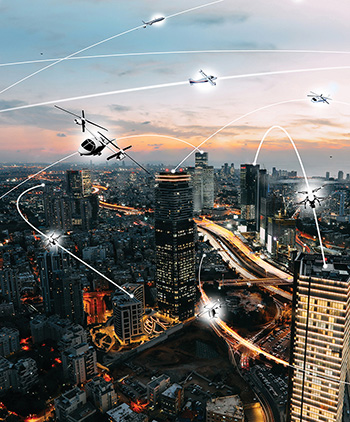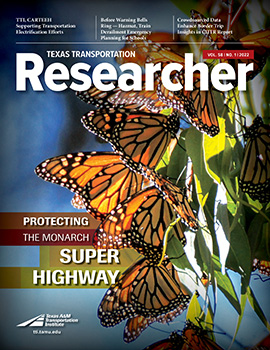Unmanned aerial vehicles (UAVs), or drones as they are commonly referred to, can carry out many impressive tasks, such as capturing stunning visual images, delivering packages, or carrying out complex military operations. While the use of UAVs is not new, their widespread use and seemingly unlimited potential in urban and rural areas have necessitated the formation of an Urban Air Mobility (UAM) Advisory Committee in Texas.

In spring 2021, the Texas Legislature passed Senate Bill 763 in the 87th regular session, requiring the Texas Transportation Commission to establish the UAM Advisory Committee. The Federal Aviation Administration defines UAM as “a safe and efficient aviation transportation system that will use highly automated aircraft to operate and transport passengers or cargo at lower altitudes within urban and suburban areas.”
“This is an industry that takes advantage of a lot of new technologies in the automated and connected space,” says Texas A&M Transportation Institute (TTI) Senior Research Scientist Jeff Borowiec. “Because of that, there is a need to collaborate across government levels and with the private sector to ensure we develop a system that works for all groups. There are a lot of issues involved when we deploy this kind of technology in urban areas, such as where are they going to land, what is the noise level, are we creating a visual nuisance, and what are the land use implications?”
The Texas Department of Transportation’s (TxDOT’s) Strategy and Innovation Division and Aviation Division began working with TTI in fall 2021 to assist the department in supporting the work of the UAM Advisory Committee upon its establishment.
“TTI is assisting TxDOT by developing a literature review and background research for the committee as well as a review of activity in other states,” says Borowiec. “TTI will also provide supporting materials and assistance to the committee and TxDOT during any public meetings where input on urban air mobility will be received. In this report, a framework for the final report and an outline of the main issues and challenges related to urban air mobility are presented for the committee’s review and discussion.”
Beyond the urban environment, the committee is addressing issues in rural areas as UAM has given way to advanced air mobility (AAM). The purpose of this evolution toward AAM is to be more inclusive of the types of services these new technologies can provide, the business use cases they can offer and the potential markets they can serve beyond Texas’s urban areas.
